Radiant Cooling: The modern approach to keeping cool

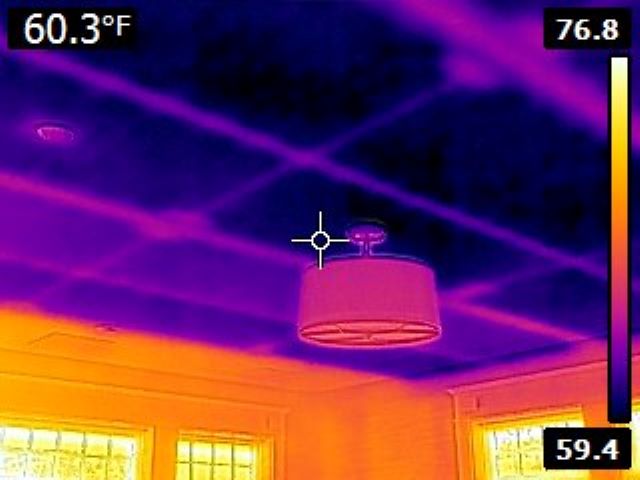
In today’s ever-evolving world of technology and comfort, radiant cooling stands out as an efficient and innovative method of cooling buildings. Often misunderstood, let’s delve into the science and practicality of this fascinating technology.
What is Radiant Cooling in short?
Radiant cooling is an energy-efficient cooling technology that, unlike traditional forced-air systems that cool the air, employs chilled radiant surfaces like ceilings or floors to directly absorb the heat radiated by objects and people within a space. It creates a comfortable, even distribution of coolness, without the need for visible and noisy equipment.
Did you know?
Defining "cold" isn't as straightforward as it seems. Unlike heat, or thermal energy, which we can define as kinetic energy arising from the vibration of particles of matter, "cold" doesn't have a direct physical counterpart. Instead, we perceive cold as the absence of heat.
Understanding Radiant Cooling
The second law of thermodynamics states that heat flows from hotter bodies to cooler ones. Take, for instance, an ice cube on a hot day, melting as the heat from the surrounding environment infiltrates it, transforming the ice into water. So, how does this heat transfer take place? This occurs through three fundamental mechanisms:
- 1. Conduction
- 2. Convection
- 3. Radiation
Conduction involves direct contact between objects, allowing heat to move from one to another. Convection, on the other hand, pertains to the movement of heat through air (or liquid). Finally, radiation—or more specifically, thermal radiation—refers to the transmission of heat via electromagnetic waves.
In the context of HVAC systems, radiant cooling is primarily based on this mechanism of thermal radiation. It’s important to note, however, that it is not about transferring “cold.” Instead, it represents a form of negative heat transfer—essentially, it’s the opposite of radiant heating.
The Feeling of Radiant Cooling
Have you ever walked along the refrigerator aisle in a supermarket? That sudden chill you feel isn’t because the fridge is emitting cold, but rather, your body’s heat is being drawn towards the cooler environment of the fridge. Similarly, the sensation you’d experience with a radiant cooling system is reminiscent of that chill you feel when near the supermarket’s fridge aisle.
Just like the fridge, these systems absorb the heat radiated by your body and any other objects in the room, creating an overall sensation of comfort.
It’s a more subtle and evenly distributed cooling experience compared to traditional air conditioning systems, which cool the air, often resulting in drafts and uneven temperatures. With a radiant cooling system, you enjoy a quiet, draft-free environment with a consistent temperature, contributing to a far more comfortable and enjoyable living or working space.
Did you know?
While the concept of "heat" has a clear scientific definition, "cool" doesn't! However, nerve endings in our skin called thermoreceptors gauge our sensation of cold.
- Heat receptors (Ruffini endings): These are sensitive to warmth.
- Cold receptors (end-bulbs of Krause): Cooler temperatures activate these receptors.
How does Radiant Cooling work?
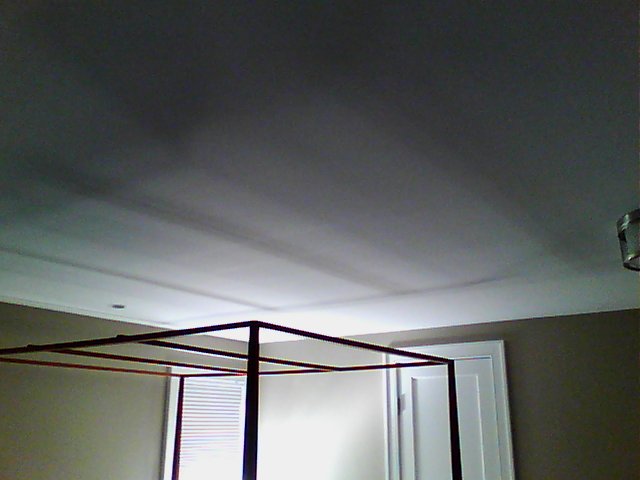
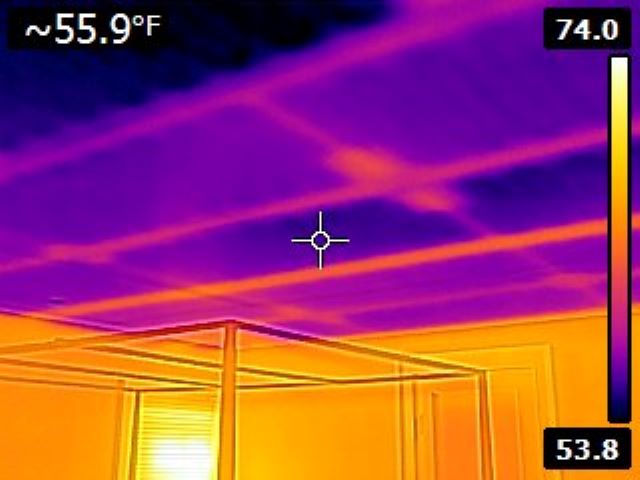
Radiant floor heating, a popular choice among homeowners, operates by circulating warm water through pipes embedded in the floor. This warms up the floor, which then radiates heat upwards, warming objects and people directly without primarily heating the air.
On the flip side, radiant cooling builds upon this concept but in the opposite manner. While it can be achieved using floors, it’s more commonly facilitated through radiant panels embedded in the ceiling. Chilled water flows through these panels, cooling the ceiling’s surface. This cooled surface then absorbs the infrared heat radiation from objects and people in the room, providing a direct sensation of coolness.
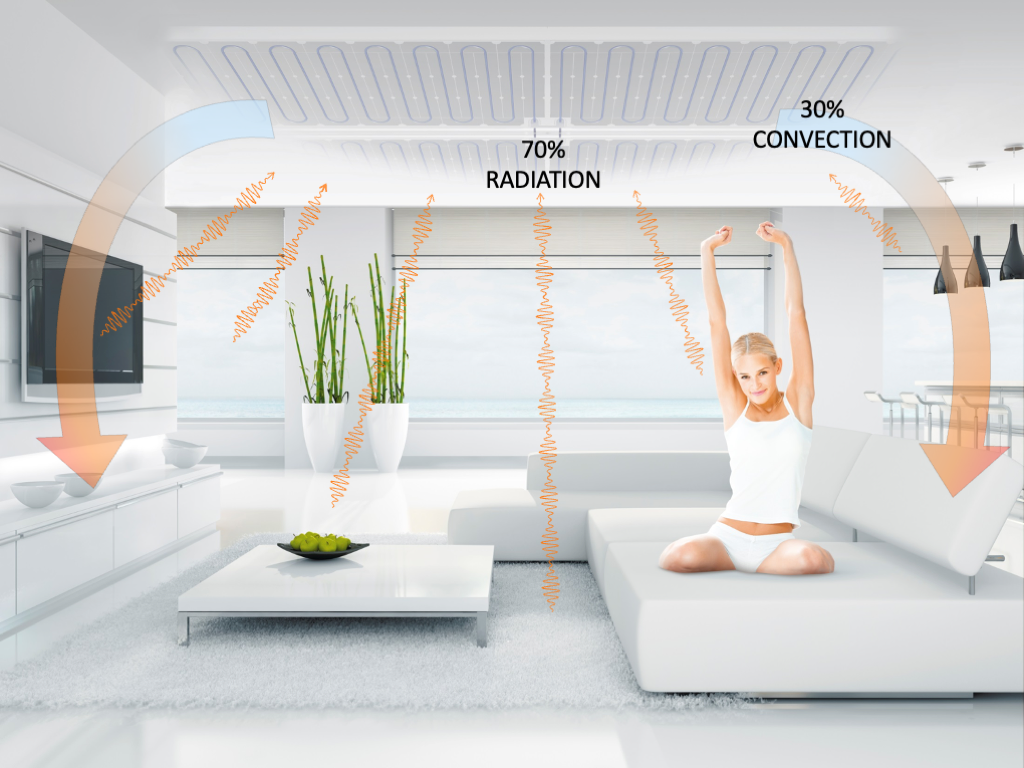
Additional 30% convection in ceiling-based radiant cooling
One distinct advantage of ceiling-based radiant cooling is the added convection component. The thin layer of air in direct contact with the cold ceiling surface gets cooled and descends, then it’s replaced by warmer air from below. This continuous downward flow of cooler air sets up a convective loop. This natural convection process contributes to around 30% of the total cooling capacity. The remaining 70% stems directly from radiation or the absorption of heat through thermal radiation. In contrast, floor-based radiant cooling relies solely on radiation, with no convection component.
Heat Pumps: Powering the Hydronic System
Being a hydronic system, Heat Pumps are often employed to produce the required chilled water. These Heat Pumps are adept at transferring heat. As the cold ceiling absorbs heat, the water flowing through the radiant panels warms up and re-enters the Heat Pump. Here, it is re-cooled and circulated back into the system, forming a closed loop that continuously removes heat from the indoor environment and discharges it outdoors.
In essence, radiant cooling is unique in its approach. Rather than battling warm air, as is common with traditional systems, it directly tackles the heat sources within a space. This results in a more efficient and evenly spread cooling experience.
Messana Ray Magic® NK radiant ceiling panels
High-efficiency radiant ceiling panels, such as Messana Ray Magic® NK, deliver excellent heat transfer and outperform many other ceiling systems in both energy efficiency and overall performance. Additionally, these ceiling panels excel in radiant cooling applications.
Ensuring Optimal Performance
Fluid temperature control and dehumidification are two critical components a system must address for flawless operation.
- Fluid Temperature Control: This system ensures that the temperature of the radiant surface remains above the room’s dew point. Falling below this temperature might cause condensation, a no-no for the system. Modern control systems utilize precise measurements and algorithms to strike the right balance, optimizing comfort and efficiency.
- Dehumidification: By effectively managing humidity levels, radiant cooling systems can leverage cooler water, thereby elevating their cooling output.
But, is dehumidification required for a radiant cooling system to prevent condensation?
10 Facts you might not know about Radiant Cooling
Cooling Capacity
A system at its maximum can provide up to 35 Btu/sq.ft on the ceiling and 15-20 Btu/sq.ft on the floor.
Fast Response Time
Modern radiant cooling systems with low mass ceiling panels can react relatively quickly to changes in thermostat settings, debunking the myth that radiant systems are slow.
Energy Efficiency
According to detailed simulations by the Lawrence Berkeley National Laboratory (LBNL), radiant cooling systems save 30% on average in overall cooling energy, ranging from 17% in cold, moist areas to 42% in warmer, dry areas.
Historical Roots
While the Romans earned recognition for their radiant floor heating, some believe that the Egyptians designed their constructions to cool down walls by flowing cold water through cavities — an early concept of radiant cooling.
European Adoption
Over the last four decades, Europe has widely adopted this technology, aligning with their modern architectural designs and HVAC innovations.
Higher Setpoint
This technology promotes heat exchange between our body and the surroundings, allowing the room set-point to be typically set about 4-6°F higher than in traditional all-air AC systems.
Floor vs. Ceiling
Globally, there are more installations in floors than in ceilings and contractors can retrofit radiant floor easily for cooling, given the right controls with the appropriate controls.
Italian Legacy
Italy leads the world in radiant cooling installations, followed by Germany and China. This prominence in Italy is largely due to Roberto Messana, considered the father of modern radiant cooling technology.
Tech Giants’ Choice
Notable Silicon Valley office spaces, including those of Apple and Microsoft, have adopted these systems, indicating the tech world’s acknowledgment of its benefits: comfort and increased productivity.
Sensory Perception
The sensation of radiant cooling is recognized by our skin’s cold receptors, known as end-bulbs of Krause, allowing us to feel the cooling effect more directly.
Wrapping Up
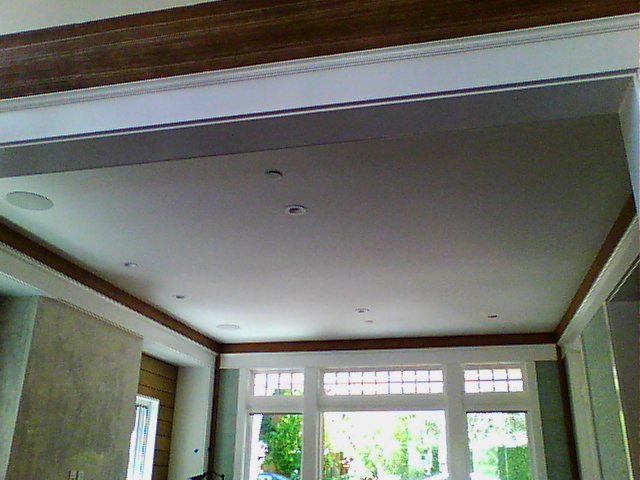
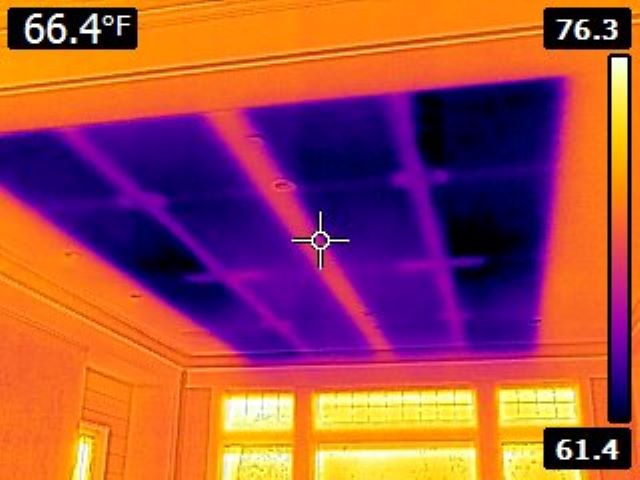
Radiant cooling is a testament to how understanding basic principles of heat transfer can lead to innovative solutions in temperature regulation.
Not only is it efficient, but it’s also a more natural way to keep indoor environments comfortable. As demand for sustainable and effective cooling technologies grows, radiant cooling stands at the forefront for a cooler, more comfortable future.
Finally, at Messana Hydronic Technologies, our team of experts specialize in designing hydronic systems. We’re here to help you navigate the options and determine the best solution for your specific needs and space.
Interested in learning more?
We offer a free consultation and free estimate. Without delay, get a free estimate from our team today!
Hydronic systems are an investment in comfort and efficiency, providing you with a superior heating and cooling solution. Trust Messana to guide you on this journey to ultimate indoor comfort.